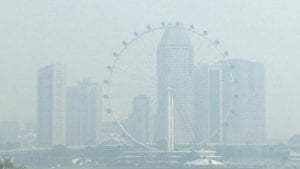What is this project about?
Problem we want to solve:
With the onset of an ever increasing demand for goods and services, rapidly advancing technologies and companies trying to outcompete each other to earn the highest profits, there have also been severe impacts on our environment, mainly pollution, deforestation, global warming, etc.. To have access to clean air, drinkable water or shelter can be considered basic human rights. However, very unfortunately, in certain cases, we find ourselves being unable to even have access to some of humans’ basic rights; clean air. In countries like Singapore or China, there have been multiple occasions where the quality of air has been less than desirable.
In Singapore, we have had haze yearly due to Indonesian farmers burning peatlands (waterlogged forests that contain high levels of carbon) in order to clear land for growing profitable crop like palm trees (which give palm oil). This has resulted in toxic haze spreading all across Southeast Asia and has affected Malaysia as well. It is well-known that the haze is dangerous. However, do people really know why the haze is dangerous and what types of particles are present in the air where there is haze? Haze is made of unburnt soot and as much as 94% of the particles present are less than 2.5 micrometers (0.000001 meters, basically very small) in diameter. Although the haze has been an annual problem during the drier periods of July to October (when burning peaks), there has been an exceptionally harmful period of haze in 2015 when Singapore’s Pollutant Standard Index (PSI) levels had hit above 300, a level that was said to be hazardous. Such high levels of pollution could cause people to suffer from decreased lung function and even bronchitis (lung inflammation). Patients with existing health conditions like asthma would have been even more severely affected by the haze.

In another part of Asia, the economic superpower, China has also been facing problems with environmental degradation and pollution. In the past few years, China has been rapidly advancing in terms of economic growth and technological growth. The emergence of a manufacturing boom in China has seen increasing numbers of factories, numbering up to about 2,000,000 in 2017. Although this has created jobs for millions of people in China, lifting a large portion of the population out of poverty, this has caused a lot of air pollution in China, and there have been instances where the pollution was so bad that it had even blocked the sunlight from their solar panels. Waste material from factories often include toxic gases like sulfur oxides, nitrous oxides and ozone. Short-term exposure to such gases can cause irritation to lungs and cause symptoms of coughing and shortness of breath. Long-term exposure can result in harm to the respiratory system and may even lead to death. Such gases may even aggravate pre-existing conditions like asthma and chronic bronchitis.

“No mask how?” How we intend on solving this problem:
To combat this, we have decided to create a portable air filter, lightweight enough to bring around, even on the go, to provide constant stream of clean air. This filter is aimed to help remove particulate matter of diameter that is less than 2.5 micrometers from the air, which allows Singaporeans to be able to use this filter during July to October, when the haze is most prevalent and to clean the air of common harmful pollutants like nitrogen oxides and sulfur oxides, which have severe health effects on people from China in the winter months.
Goals of our project:
- Increased convenience of being able to bring the filter out with you (allowing for movement even during unhealthy air conditions)
- Increased accessibility by making it cheaper (using household/ commonly found items that are easier to procure and hence lower cost and make it easier for people with lower incomes to be able to get it as well)
- Increased sustainability by making the parts washable which allows for the material to be largely reusable (reduce waste and damage to the environment)